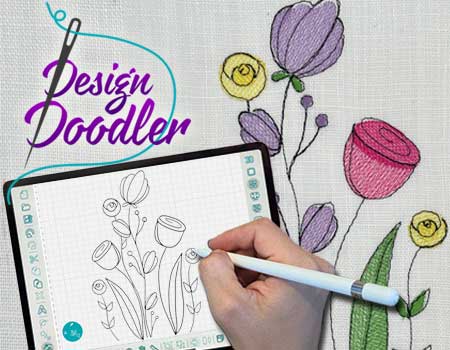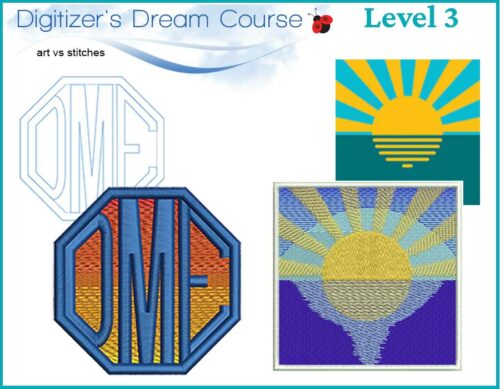-
 Level 1 is where we suggest everyone starts whether you’re completely new to digitizing or have been at it for a while. In this level, you’ll learn some of embroidery’s best kept ‘secrets’ & build a solid foundation of embroidery theory. This lesson heavily focuses on the running stitch as it is the primary stitch type used in machine embroidery.
Level 1 is where we suggest everyone starts whether you’re completely new to digitizing or have been at it for a while. In this level, you’ll learn some of embroidery’s best kept ‘secrets’ & build a solid foundation of embroidery theory. This lesson heavily focuses on the running stitch as it is the primary stitch type used in machine embroidery. -
 Ready to doodle, sketch and trace your way to custom embroidery designs? These premium lessons will quickly teach you the ropes and familiarize you with your amazing new Design Doodler software! Featuring an introductory session by John Deer, expert embroidery lessons by Linda Rayburn, and professional artistic tutorials by Daryl Stephenson, this series will help you turn your imagination into stitches – all without digitizing!
Ready to doodle, sketch and trace your way to custom embroidery designs? These premium lessons will quickly teach you the ropes and familiarize you with your amazing new Design Doodler software! Featuring an introductory session by John Deer, expert embroidery lessons by Linda Rayburn, and professional artistic tutorials by Daryl Stephenson, this series will help you turn your imagination into stitches – all without digitizing! -
-
-
 Level 1 is where we suggest everyone starts whether you’re completely new to digitizing or have been at it for a while. In this level, you’ll learn some of embroidery’s best kept ‘secrets’ & build a solid foundation of embroidery theory. This lesson heavily focuses on the running stitch as it is the primary stitch type used in machine embroidery.
Level 1 is where we suggest everyone starts whether you’re completely new to digitizing or have been at it for a while. In this level, you’ll learn some of embroidery’s best kept ‘secrets’ & build a solid foundation of embroidery theory. This lesson heavily focuses on the running stitch as it is the primary stitch type used in machine embroidery. -
 Level 1 is where we suggest everyone starts whether you’re completely new to digitizing or have been at it for a while. In this level, you’ll learn some of embroidery’s best kept ‘secrets’ & build a solid foundation of embroidery theory. This lesson heavily focuses on the running stitch as it is the primary stitch type used in machine embroidery.
Level 1 is where we suggest everyone starts whether you’re completely new to digitizing or have been at it for a while. In this level, you’ll learn some of embroidery’s best kept ‘secrets’ & build a solid foundation of embroidery theory. This lesson heavily focuses on the running stitch as it is the primary stitch type used in machine embroidery. -
 Level 1 is where we suggest everyone starts whether you’re completely new to digitizing or have been at it for a while. In this level, you’ll learn some of embroidery’s best kept ‘secrets’ & build a solid foundation of embroidery theory. This lesson heavily focuses on the running stitch as it is the primary stitch type used in machine embroidery.
Level 1 is where we suggest everyone starts whether you’re completely new to digitizing or have been at it for a while. In this level, you’ll learn some of embroidery’s best kept ‘secrets’ & build a solid foundation of embroidery theory. This lesson heavily focuses on the running stitch as it is the primary stitch type used in machine embroidery. -
 Level 1 is where we suggest everyone starts whether you’re completely new to digitizing or have been at it for a while. In this level, you’ll learn some of embroidery’s best kept ‘secrets’ & build a solid foundation of embroidery theory. This lesson heavily focuses on the running stitch as it is the primary stitch type used in machine embroidery.
Level 1 is where we suggest everyone starts whether you’re completely new to digitizing or have been at it for a while. In this level, you’ll learn some of embroidery’s best kept ‘secrets’ & build a solid foundation of embroidery theory. This lesson heavily focuses on the running stitch as it is the primary stitch type used in machine embroidery. -
-
 Level 1 is where we suggest everyone starts whether you’re completely new to digitizing or have been at it for a while. In this level, you’ll learn some of embroidery’s best kept ‘secrets’ & build a solid foundation of embroidery theory. This lesson heavily focuses on the running stitch as it is the primary stitch type used in machine embroidery.
Level 1 is where we suggest everyone starts whether you’re completely new to digitizing or have been at it for a while. In this level, you’ll learn some of embroidery’s best kept ‘secrets’ & build a solid foundation of embroidery theory. This lesson heavily focuses on the running stitch as it is the primary stitch type used in machine embroidery. -
-
-
-
-
-
-
-
 Level 1 is where we suggest everyone starts whether you’re completely new to digitizing or have been at it for a while. In this level, you’ll learn some of embroidery’s best kept ‘secrets’ & build a solid foundation of embroidery theory. This lesson heavily focuses on the running stitch as it is the primary stitch type used in machine embroidery.
Level 1 is where we suggest everyone starts whether you’re completely new to digitizing or have been at it for a while. In this level, you’ll learn some of embroidery’s best kept ‘secrets’ & build a solid foundation of embroidery theory. This lesson heavily focuses on the running stitch as it is the primary stitch type used in machine embroidery. -
-
-
-
-
 The Creative Digitizing Bundle is an exclusive bonus which you’ve received free for purchase level 1 of the ‘Digitizer’s Dream Course’. This non-software specific bundle has sold over 10,000 copies & will dive deep into the theory of digitizing. It will also teach more advanced techniques such as applique, fringe, foam, animals, nature & more.
The Creative Digitizing Bundle is an exclusive bonus which you’ve received free for purchase level 1 of the ‘Digitizer’s Dream Course’. This non-software specific bundle has sold over 10,000 copies & will dive deep into the theory of digitizing. It will also teach more advanced techniques such as applique, fringe, foam, animals, nature & more. -
 Level 1 is where we suggest everyone starts whether you’re completely new to digitizing or have been at it for a while. In this level, you’ll learn some of embroidery’s best kept ‘secrets’ & build a solid foundation of embroidery theory. This lesson heavily focuses on the running stitch as it is the primary stitch type used in machine embroidery.
Level 1 is where we suggest everyone starts whether you’re completely new to digitizing or have been at it for a while. In this level, you’ll learn some of embroidery’s best kept ‘secrets’ & build a solid foundation of embroidery theory. This lesson heavily focuses on the running stitch as it is the primary stitch type used in machine embroidery. -
 Level 1 is where we suggest everyone starts whether you’re completely new to digitizing or have been at it for a while. In this level, you’ll learn some of embroidery’s best kept ‘secrets’ & build a solid foundation of embroidery theory. This lesson heavily focuses on the running stitch as it is the primary stitch type used in machine embroidery.
Level 1 is where we suggest everyone starts whether you’re completely new to digitizing or have been at it for a while. In this level, you’ll learn some of embroidery’s best kept ‘secrets’ & build a solid foundation of embroidery theory. This lesson heavily focuses on the running stitch as it is the primary stitch type used in machine embroidery. -
-
-
-
0




